
![]()
AND NOW IT'S TIME TO DIVIDE:
In this lesson, we will be dividing one monomial by another monomial. The literal meaning of the exponents will help us here.
Remember that y to the third power means y times y times y.
![]()
This is NOT the same thing as 3y.
Now let's say we want to take
that
![]() and divide
it by y to the second power. It would look like this:
and divide
it by y to the second power. It would look like this:
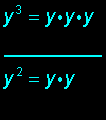
You can see that since y/y = 1, the first two y's in the numerator will
divide with the two y's in the denominator to create 1 times 1 times y.
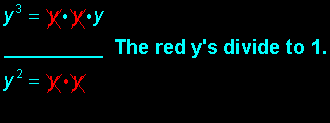
The answer is y.
*You can also get this answer by subtracting the EXPONENTS in the original problem, 3-2=1. So the answer is y to the first power.
Now let's make it a bit more complicated by adding some more variables.
Simplify:

The literal meaning is:

When we divide, one pair of
x's will divide to 1 and two pairs of y's will divide to one. This leaves
us with two x's and three y's remaining in the numerator or, x
to the second power times y to the third power.

*Again,
if we subtract the exponents in the denominator from the exponents of
the variables with like bases in the numerator, we will get the same answer.
![]() Most folks
like this method the best, because it is quick and easy to write. Actually
they do this in their heads much of the time.
Most folks
like this method the best, because it is quick and easy to write. Actually
they do this in their heads much of the time.
Let's try one more.
Simplify:

Well, 13/26 is one half. That will get us started. We can subtract the
exponents of like bases to get the rest.
Notice since there are more b's in the denominator than the numerator, the answer will have b's in the denominator.
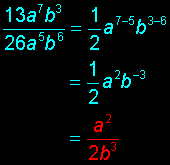
YOUR TURN:
Try these. Click the answer link to see if you got them correct.
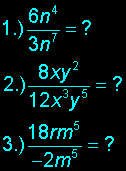
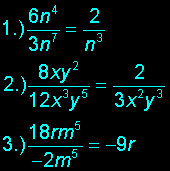

Home | About
Us | Algebra| Dictionary | Games | Geometry | Gym | Humor | Lab | Magic | Natural Math | PreAlgebra | Resources | Teachers Only | Toolbox | Treasures | Videos | Wonders | Writings |
Copyright © 1999-2020 themathlab.com
